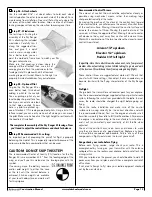
Construction Manual
www.oldschoolmodels.com
Page 13
Step 86 - Attach wheels
Use the included 3/16” i.d. wheel collars to hold each wheel
(not included) on the axles (one on each side of the wheel). For a
maintenance free installation, file a small flat on the axle where the
set screw of the wheel collar touches. Also use a touch of thread-
locking compound to keep the screw from loosening over time.
Step 87 - Windscreen
The last step in finishing the
assembly of the Sky Ranger
40 is attaching the included
windscreen. Carefully trim it
along this suggested trim-
line, and give it a quick
wash in warm, soapy water.
For a better look, you can
paint the molded in frame lines to match your Sky
Ranger’s color scheme.
Make sure that covering is clean where the
canopy will be attached, then use a bit of
canopy glue to attach the windscreen to the
fuselage. Hold it in place with a bit of low-tack
masking tape until cured. Shown to the right is a
properly trimmed windscreen for your reference.
Step 88 - Optional Pilot
To give the Sky Ranger 40 an
even better look, think about
adding a pilot to the cockpit.
You can pickup a pilot at your
local hobby shop and for a few
bucks you can add a nice look
to that open cockpit. Shown
here is a pilot we picked up -
one of Horizon’s 1/7th scale pre-painted pilots. Using a bit of the
leftover wood, you can easily make a shelf where you can mount
the pilot. Make sure his head is at the right height to rest level with
the headrest (if installed).
This completes the assembly of the Sky Ranger 40 fuselage. Now
you’ll need to adjust the control throws and check for balance.
Step 89 Recommended C.G. setting:
An important part of preparing the aircraft for flight is properly
balancing the model. This is especially important because of the
various motor/battery combinations that can be used.
CAUTION! DO NOT SKIP THIS STEP!
The recommended Center of Gravity (CG) location for the Sky
Ranger 40 is measured back 2.8” from the leading edge of the
wing, and you’ll see this marked on the fuselage plan with this
symbol.
If necessary, move the battery, receiver,
and/or add weight to either the nose
or the tail until the correct balance is
achieved. Stick-on weights are available
at your local hobby store and work well
for this purpose.
Recommended Control Throws:
The amount of control throw should be adjusted as closely as
possible using mechanical means, rather than making large
changes electronically at the radio.
By moving the position of the clevis at the control horn toward
the outermost hole, you will decrease the amount of control throw
of the control surface. Moving it toward the control surface will
increase the amount of throw. Moving the pushrod wire at the
servo arm will have the opposite effect: Moving it closer to center
will decrease throw, and away from center will increase throw.
Work with a combination of the two to achieve the closest or exact
control throws listed.
Aileron 1/2” up/down
Elevator 1/2” up/down
Rudder 3/4” left/right
(
Expert tip:
Once the control throws have been set, cut a few pieces of
medium silicone fuel tubing (or heat shrink tubing) to go around each
of the clevises. This will keep them from opening during flight.)
These control throw are suggested and work well. We ask that
you start with these settings, then adjust them as needed as you
become familiar with the flying characteristics of the Sky Ranger
40.
Preflight:
Charge both the transmitter and receiver pack for your airplane.
Use the recommended charger supplied with your particular radio
system, following the instructions provided with the radio. In most
cases, the radio should be charged the night before going out
flying.
Check the radio installation and make sure all the control
surfaces are moving correctly (i.e. the correct direction and with
the recommended throws). Test run the engine and make sure it
transitions smoothly from idle to full throttle and back. Also ensure
the engine is tuned according to the manufacturer’s instructions,
and it will run consistently and constantly at full throttle when
adjusted.
Check all the control horns, servo horns and clevises to make
sure they are secure and in good condition. Replace any items
that would be considered questionable. Failure of any of these
components in flight would mean the loss of your aircraft.
Range check your radio before flying
Before each flying session, range check your radio. This is
accomplished by turning on your transmitter with the antenna
collapsed. Turn on the radio in your airplane, but do not attach the
arming switch.
With your airplane on the ground, you should be able to walk 30
paces away from your airplane and still have complete control of
all functions.
If not, don’t attempt to fly! Have your radio equipment checked
out by the manufacturer.


































